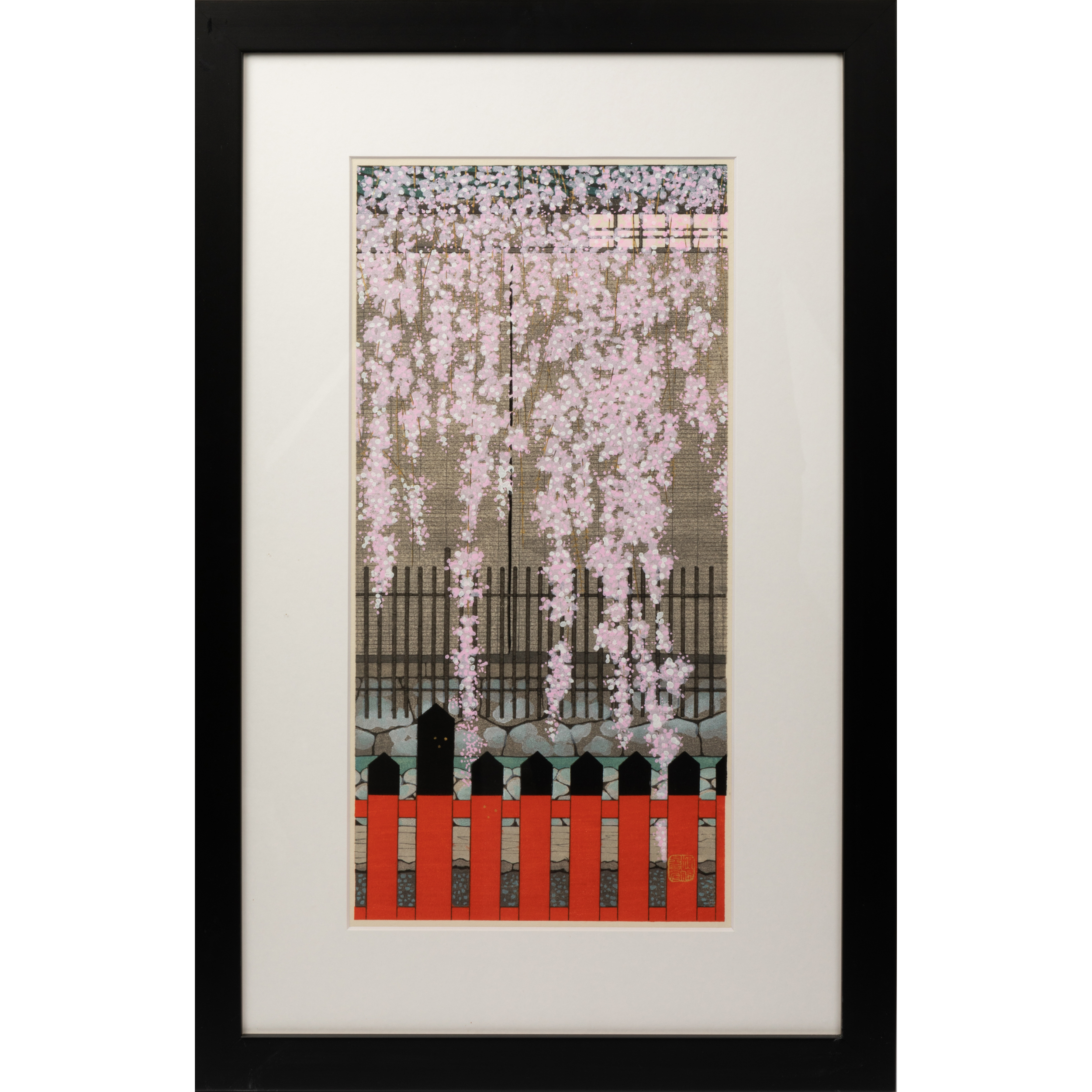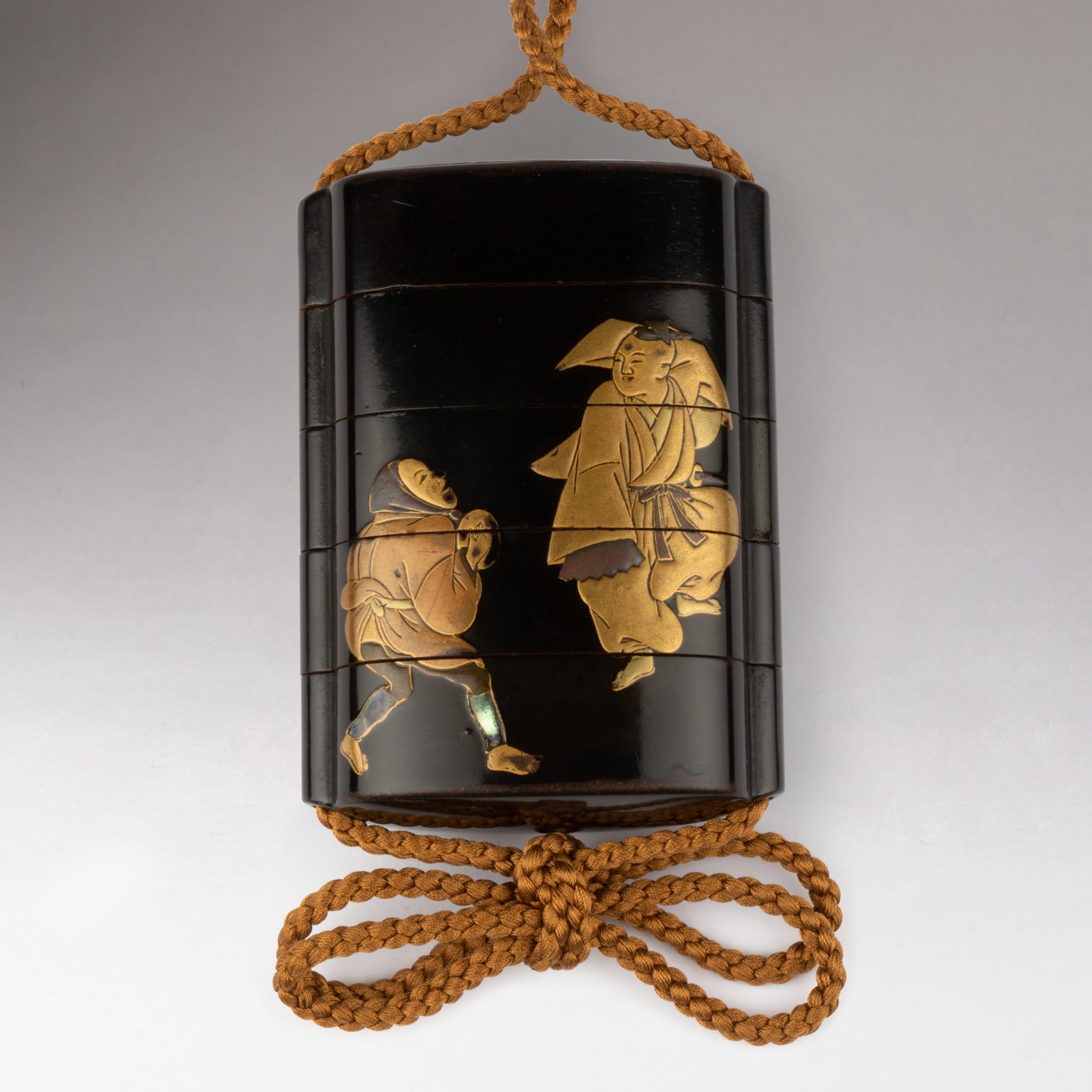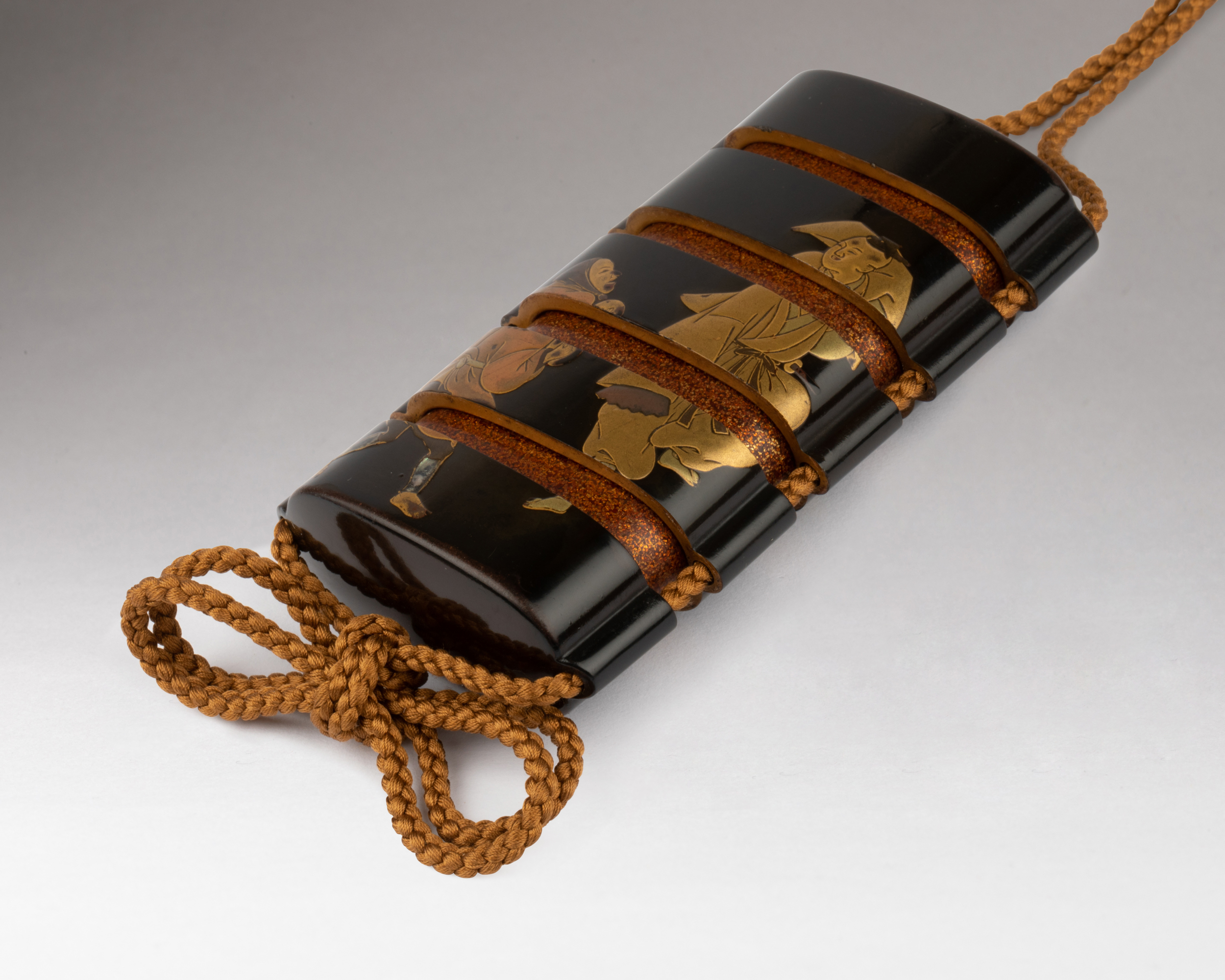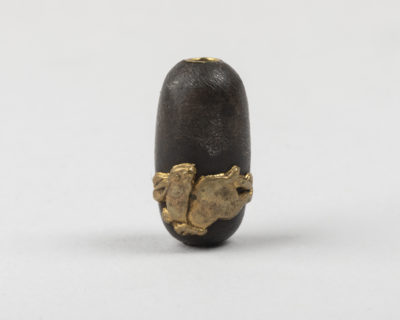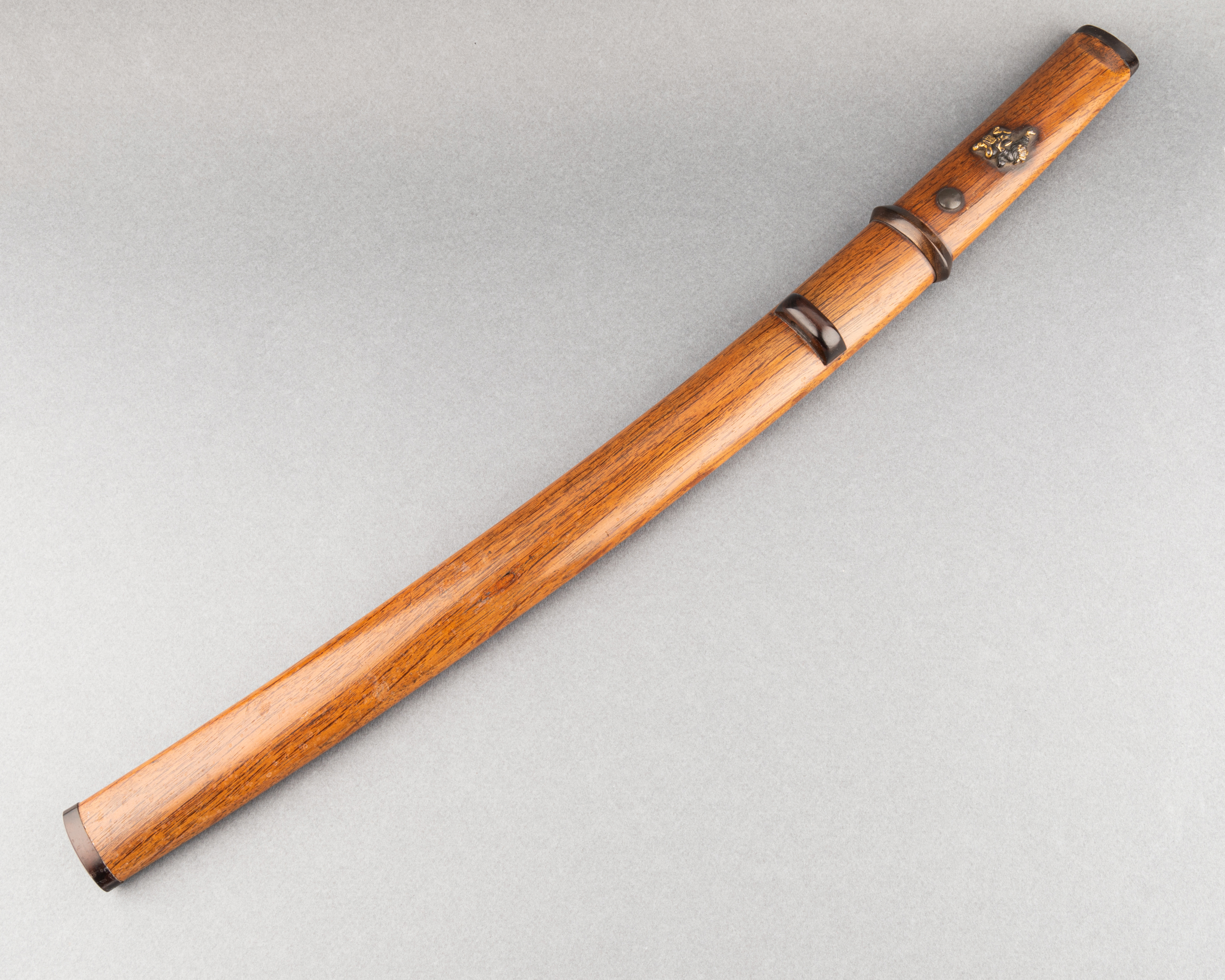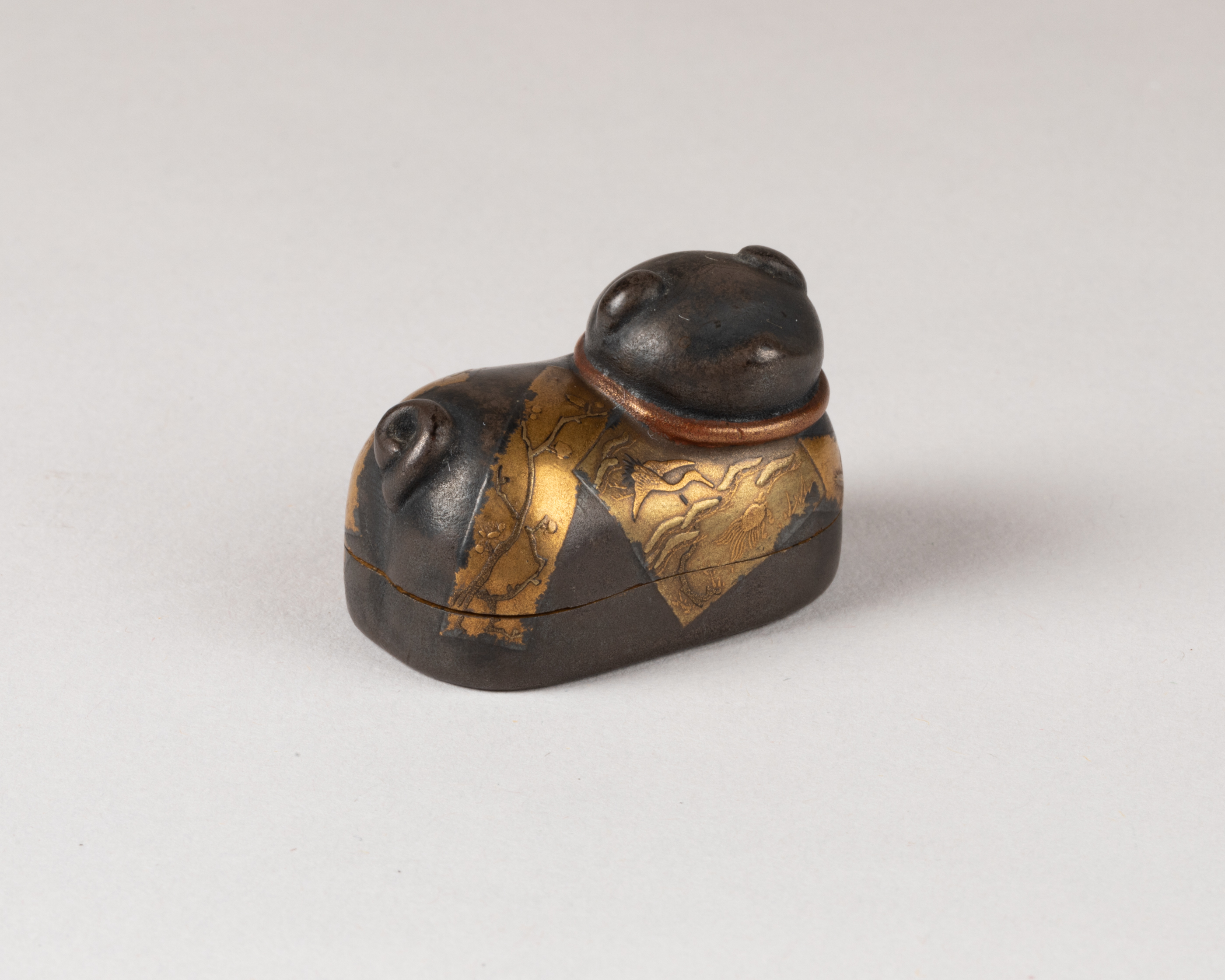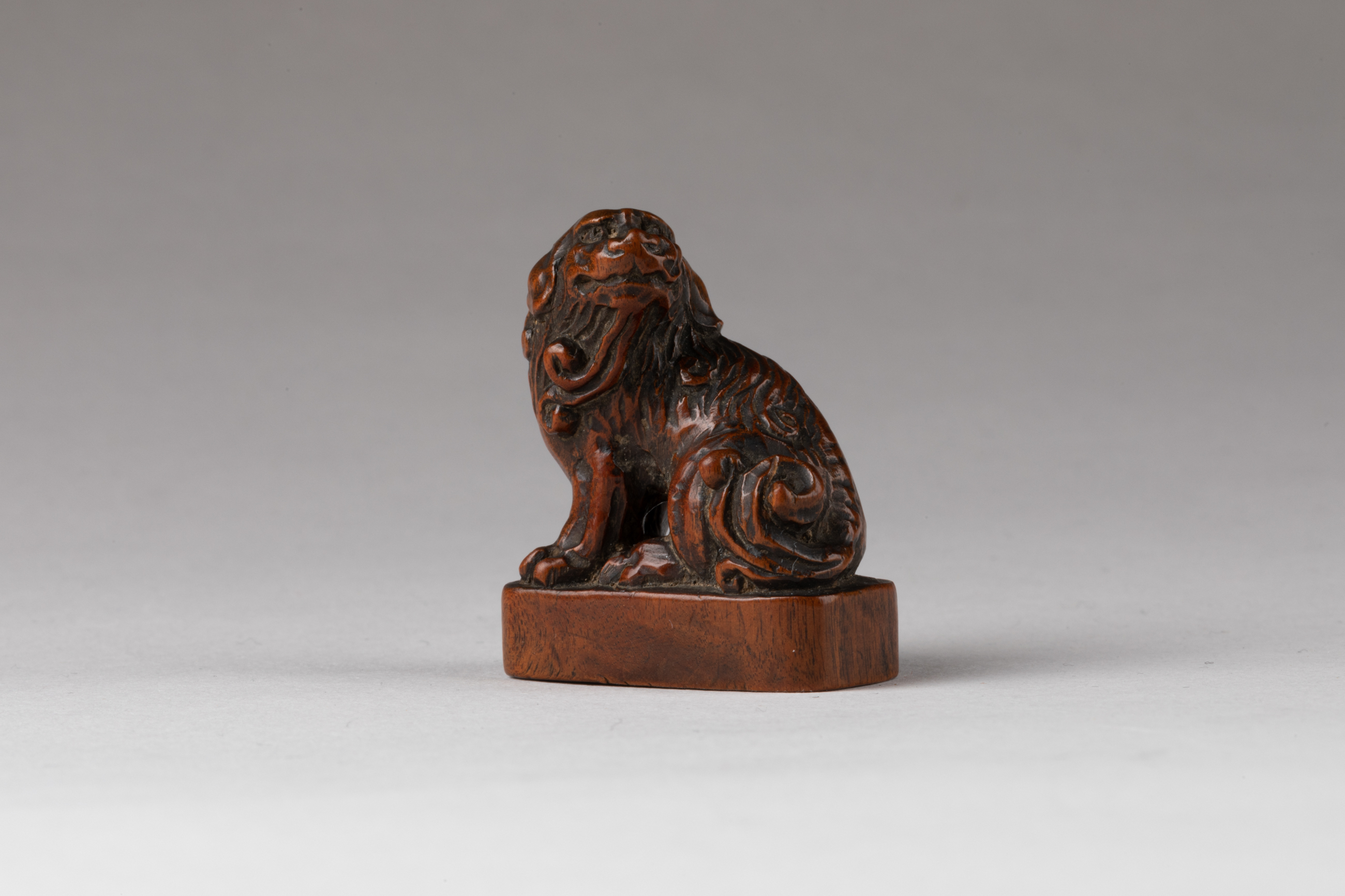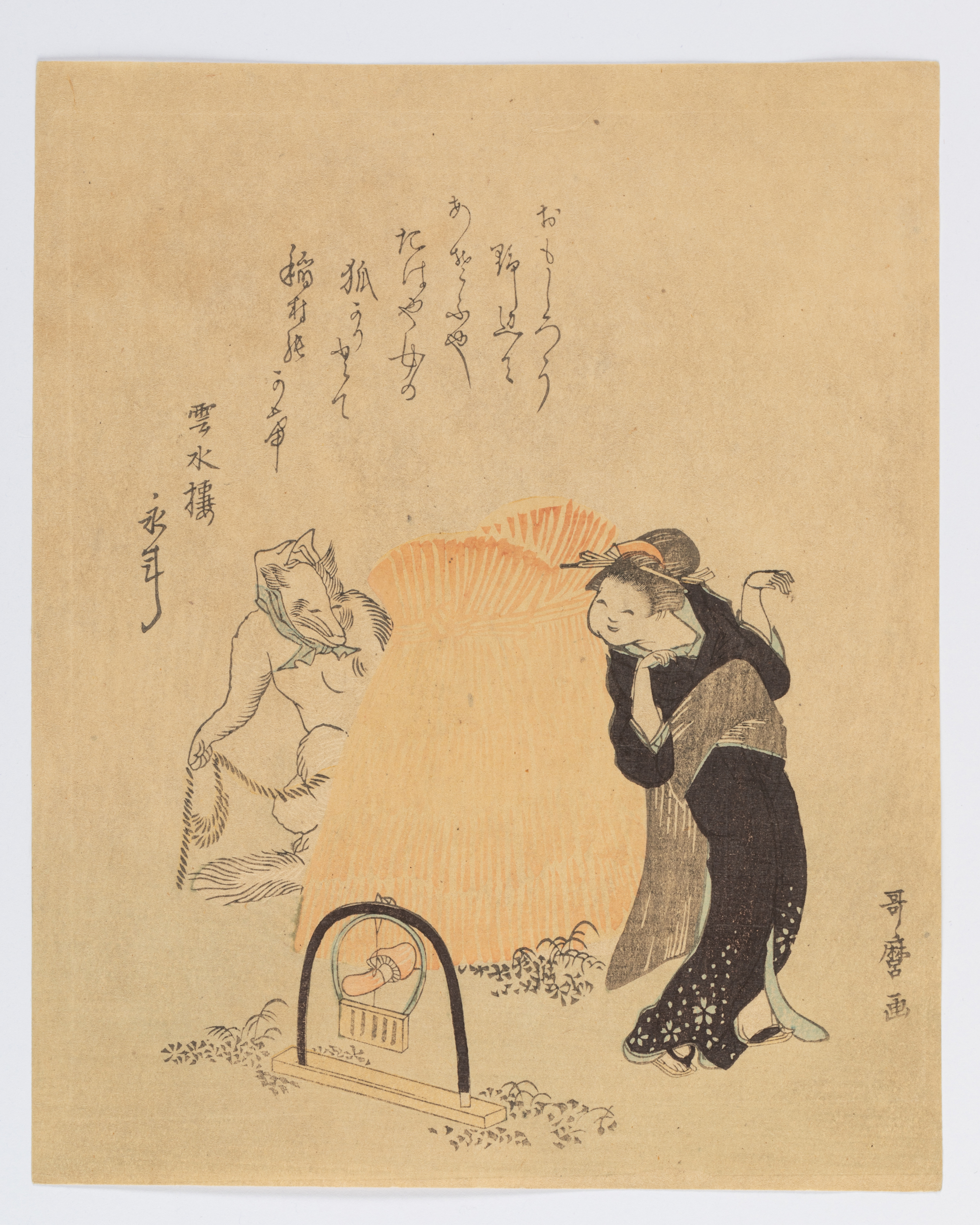Peinture – Couple de daims dans un paysage
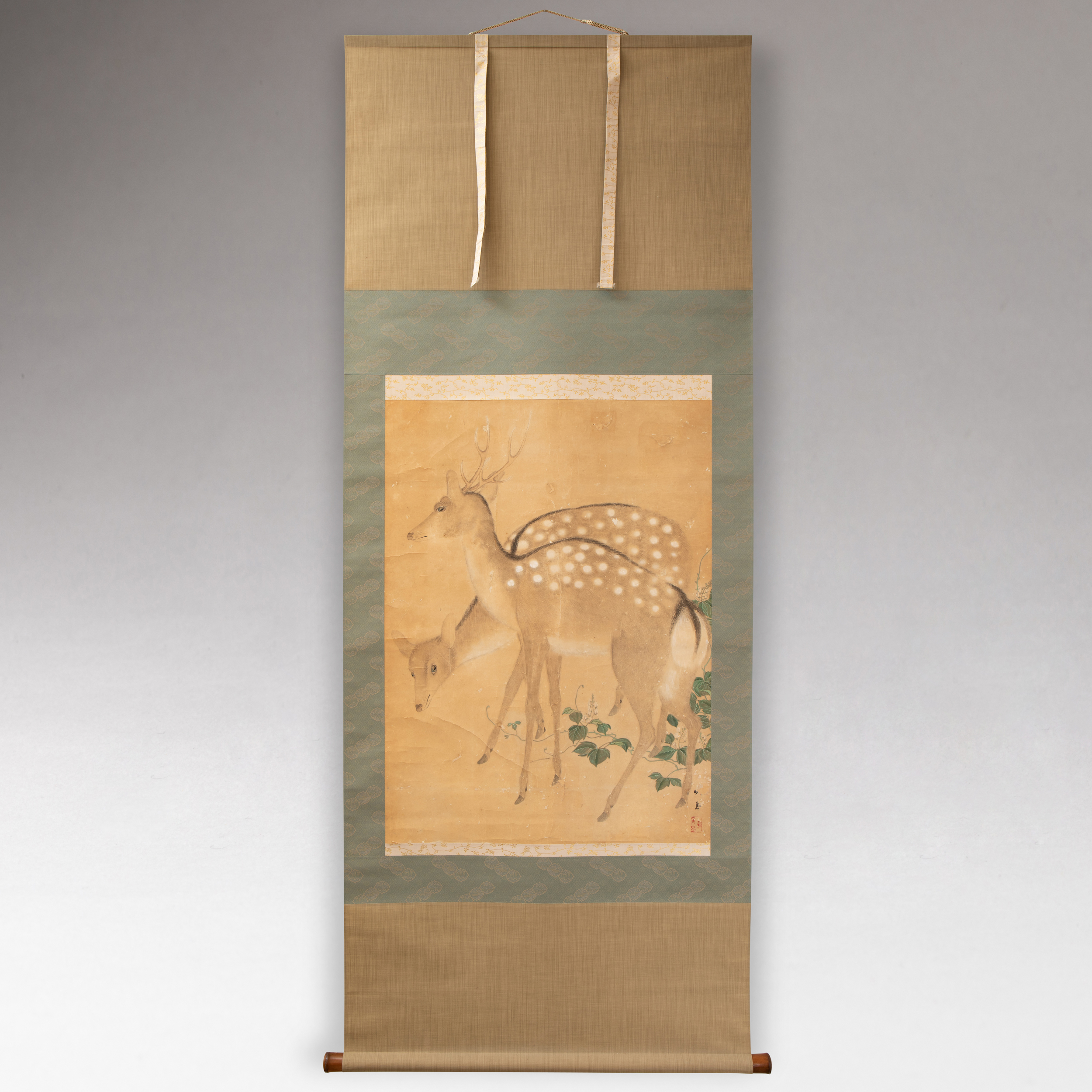
Peinture – Encre sur papier. Couples de daims dans un paysage. Paysage simplement suggéré par quelques branches d’Hostas – Urui, plantes vivaces herbacées particulièrement appréciés des cerfs. L’Hosta plantaginea originaire de Chine s’est rapidement répandue dans le centre et le sud du Japon. Grands daims sur fond beige, représentés de façon assez réaliste, au pelage caractéristique de l’animal. Signé en bas à droite Kiyo San … avec un cachet à encore rouge. Œuvre encadrée par une ravissante bordure en soie bleue brodée de motifs géométriques, sur un encadrement plus large d’une soie beige tirant sur le vert, et présentée en rouleau. Japon fin Edo (1603-1868) fin du XIXe siècle
Painting – Ink on paper. A couple of deers on a landscape. Very simple landscape with only few Hostas – Urui, plants came from China, we can find on the center and south of Japan, particularly appreciated by deers. Large format of deers on a beige ground, represented on a realistic way. Signed down on the right : Kiyo San… with a red seal. Framed with a beautiful silk bordure, presented as a roll. Japan end of Edo (1603-1868) end of 19th century
Kobako : Boîte à deux compartiments et un couvercle en laque d’or
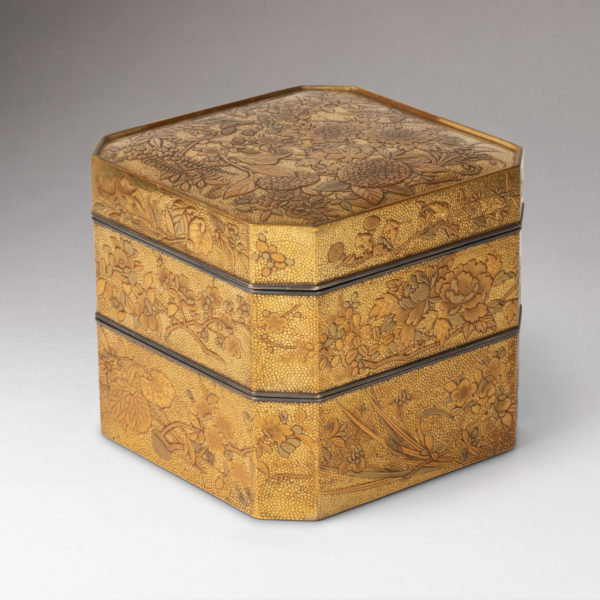
Rare Kobako octogonal à deux étages, ouvrant par deux cases et un couvercle (s’appuyant sur le rebord du corps) dit Aikuchi-zukuri, aux angles chanfreinés de forme Sumikiri, offrant un décor de multiples fleurs et feuillages parmi lesquels : glycines, pivoines, fleurs d’abricotiers et de cerisiers. Technique de laque en Takamaki-e en léger relief, et réhauts de Kirigane, en laque d’or sur fond d’or en Hirame (de larges paillettes d’or dites yeux plats). Intérieur en laque Nashiji. H : 8 cm. Japon end of Edo (1603-1868) early Meiji (1868-1912) fin du XIXe siècle.
Unusual and rare shape of a Kobako, open by two cases and a lid called Aikuchi-zukuri with chamfered corners called sumikiri, of many flowers and leafs : wisteria, peonies, abricot tree… Technique of takamaki-e in slight relief and kirigane of gold urushi lacquer, on a gold background Hirame. Nashiji inside and under the base. H : 8 cm. Japan end of Edo (1603-1868), early Meiji (1868-1912) end of 19th century
Ema – Peinture de temple à décor de chevaux
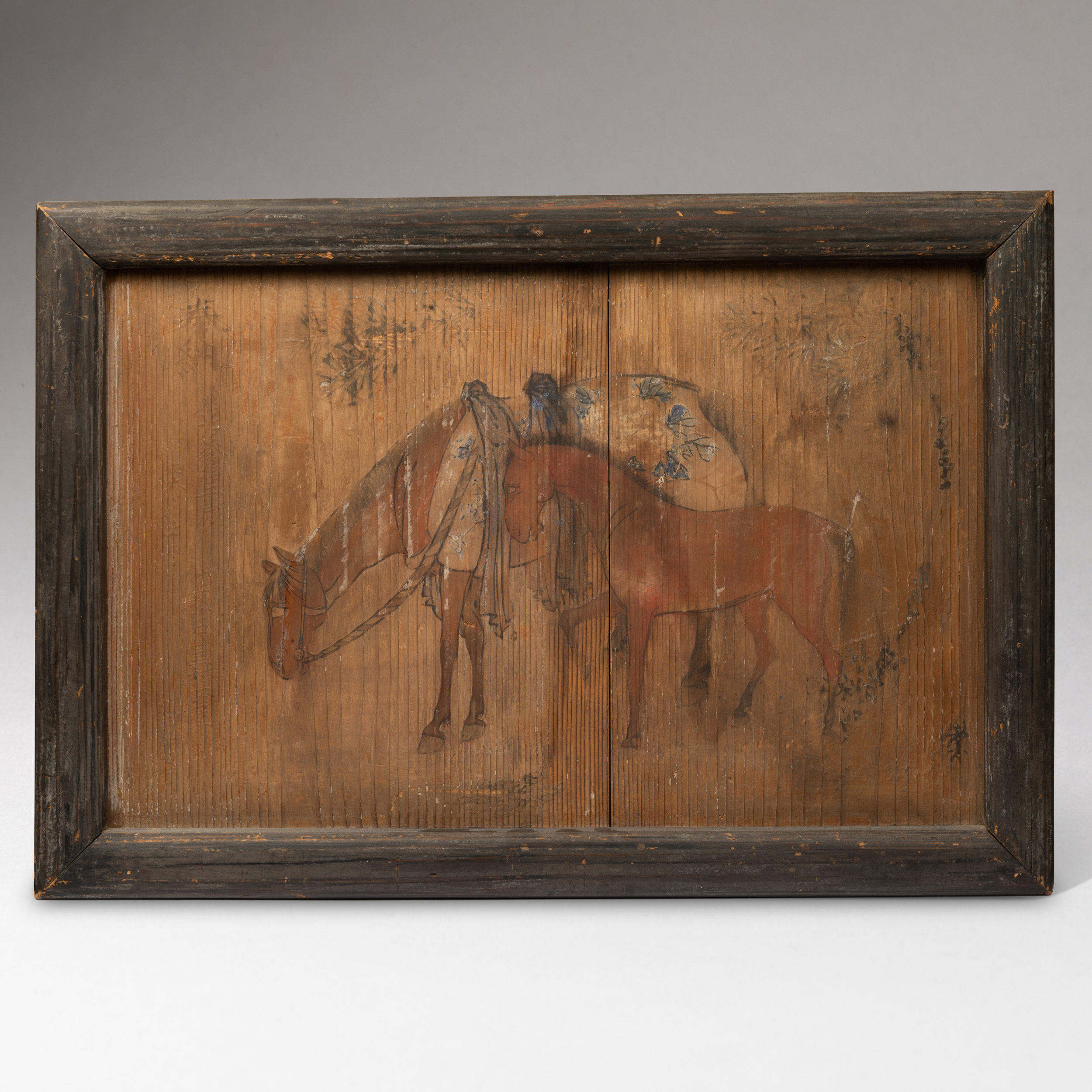
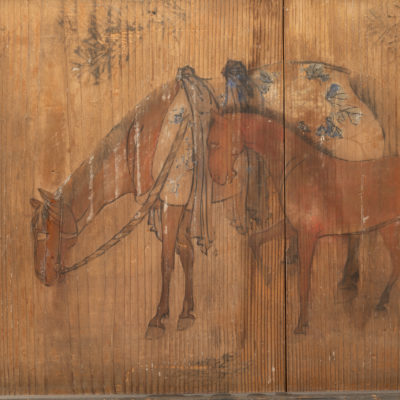
E-ma – Peinture sur une planche de bois encadrée, offerte au temple comme « ex-voto ». Le mot E-ma signifie « image de cheval » en raison d’une coutume ancienne qui consistait à offrir des chevaux au Dieux qui intercédait alors comme « messager ». On reconnaît notamment ces chevaux par leur tapis de selle nouée. Comme dans nombres de cultures, les animaux furent remplacés par des représentations, puis des représentations plus diverses d’êtres et d’objets. Le sanctuaire de Miya-jima est renommé pour sa collection d’E-ma. Dimension sans cadre : 52 x 33 cm. Japon fin Edo (1603-1868) XIXe siècle.
E-ma – A framed wood painting, as a gift for a temple. The word E-ma means « horse image » because horses were offered to the temple, given to the gods. We can recognize these horses with their saddle cloths. Miya-jima is renowned for this collection of E-ma. Size without frame : 52 x 33 cm. Japan end of Edo (1603-1868) 19th century.
Netsuke – Personnage de Ran-ryo dansant

Netsuke – Personnage de Ran-ryo danseur, en bois sculpté. Inspiré d’une légende chinoise, il porte le masque traditionnel surmonté d’un dragon, un bâton doré à la main et un est vêtu d’un costume richement orné dans une pose typique de la représentation du personnage. Grand modèle avec de jolis détails de sculpture. Le personnage donne naissance à la danse de Ran-ryo-o (bu-gaku) exécutée par un seul personnage, lors de cérémonies sportives, accompagnée de musique chinoise. Hauteur : 9,5 cm. Japon Edo (1603-1868) XIXe siècle.
Netsuke – A wood figure of Ran-ryu dancer, standing in the typical pose, carrying a golden baton, he wears a elaborated robe with the traditionnal mask. Various details of sculpture. Ran-ryo was a legendary Chinese prince whose victory in battle was always assured by wearing this fantastic mask. The Ran-ryo-o (bu-gaku) is danced by a single character, during sports ceremonies, to Chinese music. Height : 9,5 cm. Japan Edo (1603-1868) 19th century.
Naginata en laque du japon
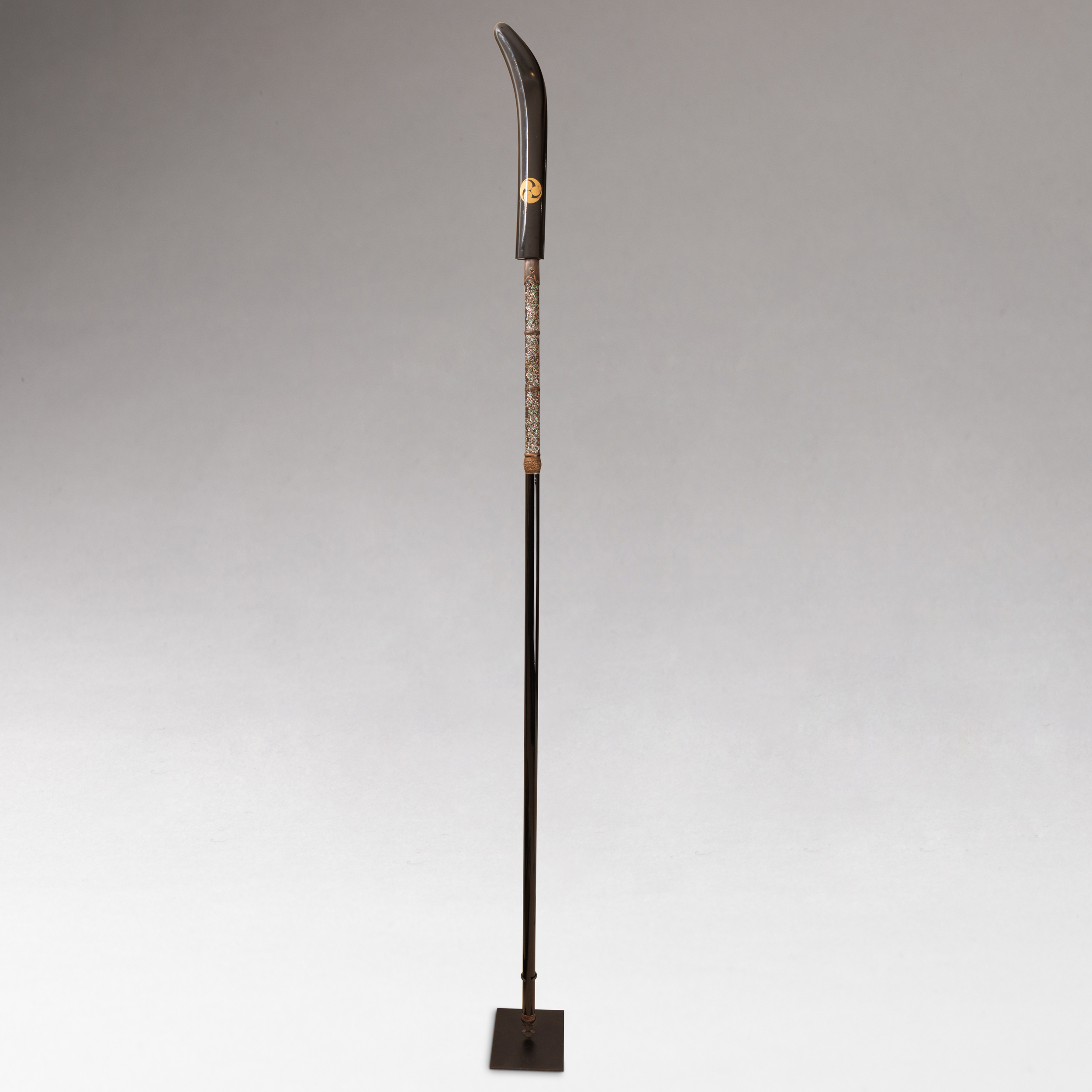
Naginata – Hallebarde japonaise, en laque du japon urushi, burgautée en partie haute (technique du Raden). Lame à la gouttière laquée rouge. Le fourreau en laque d’une hauteur de 40 cm. Môn Hidari à l’or (Mitsu tomo-yé) – blason principale de la famille Funa-Koshi (samouraï) Hauteur totale: 225 cm. Japon, Fin de la période Edo, début Meiji (1603-1868) fin du XIXe siècle. Avec son socle.
Netsuke – Shishi en buis sculpté
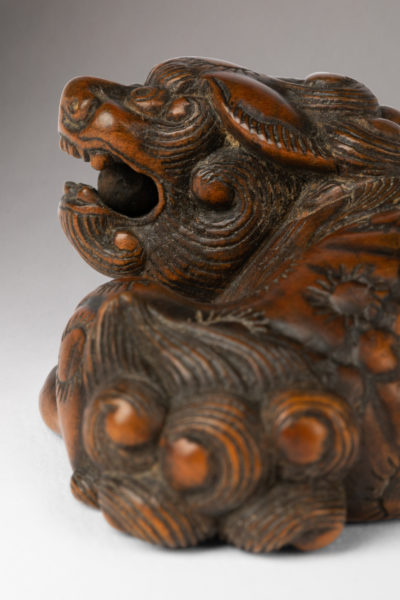
Netsuke – Shishi en buis sculpté représenté couché, se tournant du côté gauche ouvrant la gueule celle-ci laissant apparaître un boule mobile, son poil sculpté de boucles stylisées. Longueur : 4,2 cm. Larges himotoshi sous la base. Japon Edo (1603-1868) XVIIIe siècle
Netsuke – A good model of a wood Shishi reclining and turning to the left, with a strong expression, a ball on her mouth, hair sculpted with stylized curls. Large himotoshi under the base. Length: 4.2. Japan Edo (1603-1868) 18th century
Netsuke – Crapaud perché sur un seau par Masanao
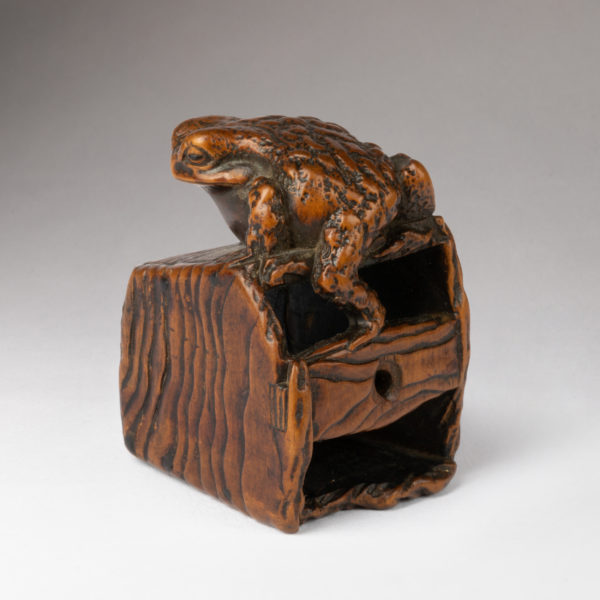
Netsuke – Ravissant crapaud finement sculpté grimpant sur un vieux baquet renversé. Jolis détails dans le rendu de la peau du crapaud et dans le veinage du bois du baquet ainsi que des petits clous fixant les planches entre elles. Présage de pluie, perché sur un veux baquet qui peut alors l’effrayer en puisant de l’eau, il symbolise la fragilité de la vie et le triomphe sur l’ennemi. Signé Masanao ( de Yamada). Hauteur : 4 cm. Japon Edo (1603-1868) XIXe siècle.
Netsuke – A good model of a toad on an old bucket, the creature climbing into the large end of the bucket with one leg trailing. The boxwood in a very good colour with a beautiful natural patina. Signed Masanao ( Yamada). An attractive exemple of this well known subject which represents the ultimate triumph of the toad over its secular enemy. H : 4 cm. Japan Edo (1603-1868) 19th century.
Netsuke – Rat sur une balayette
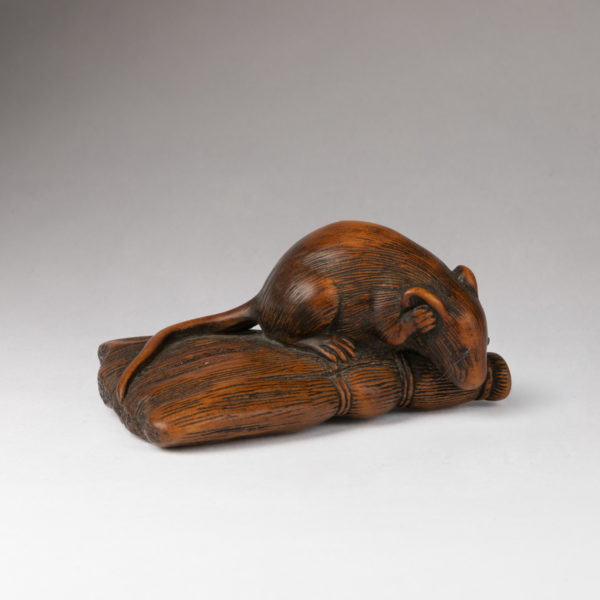
Netsuke – Ravissant modèle d’un rat en bois sculpté grimpant sur une balayette, se grattant l’oreille de sa petite patte. Les yeux sont incrustés de corne brune. Jolis détails finement sculptés. Belle patine naturelle du bois. H. 2,3 cm L. 5,1 cm. Japon Edo (1603-1868) XVIIIe siècle. Premier des animaux du zodiaque et compagnon de Daikoku, le rat est l’un des animaux les plus appréciés dans l’univers du Netsuke. Sujet fréquemment représenté, il illustre de la beauté et la simplicité de la vie de tous les jours.
Netsuke – An attractive wood model of a rat crawling over a brush, scratch his ear. Beautiful details very finely rendered and brown horn inlays for the eyes. Beautiful and old natural patina. H: 2,3 cm L. 5,1 cm. Japan Edo (1603-1868) 18th century. First of the zoodiac animals and Daikoku ‘s companion, it is a beautiful and very simple subject of dayly life.
Bokuto avec Tsuba – Sabre de médecins
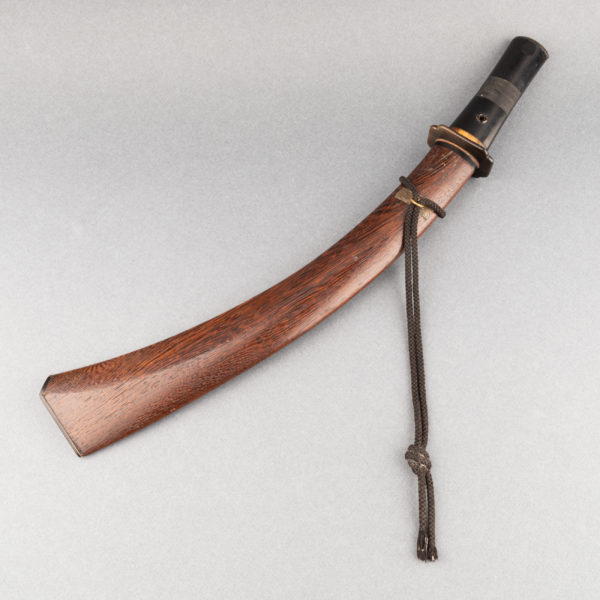
BOKUTO Sabre Japonais en bois. Art Guerrier. Corne brune et corne blonde pour le manche Japon Fin Edo, 19e siècle Longueur : 41 cm
BOKUTO Wooden Japanese Sword. Warrior Art Brown horn and blond horn for the handle Japan Late Edo, 19th century Length: 41 cm
Koson Ohara (1877-1945) Renard dansant sous un nénuphar.
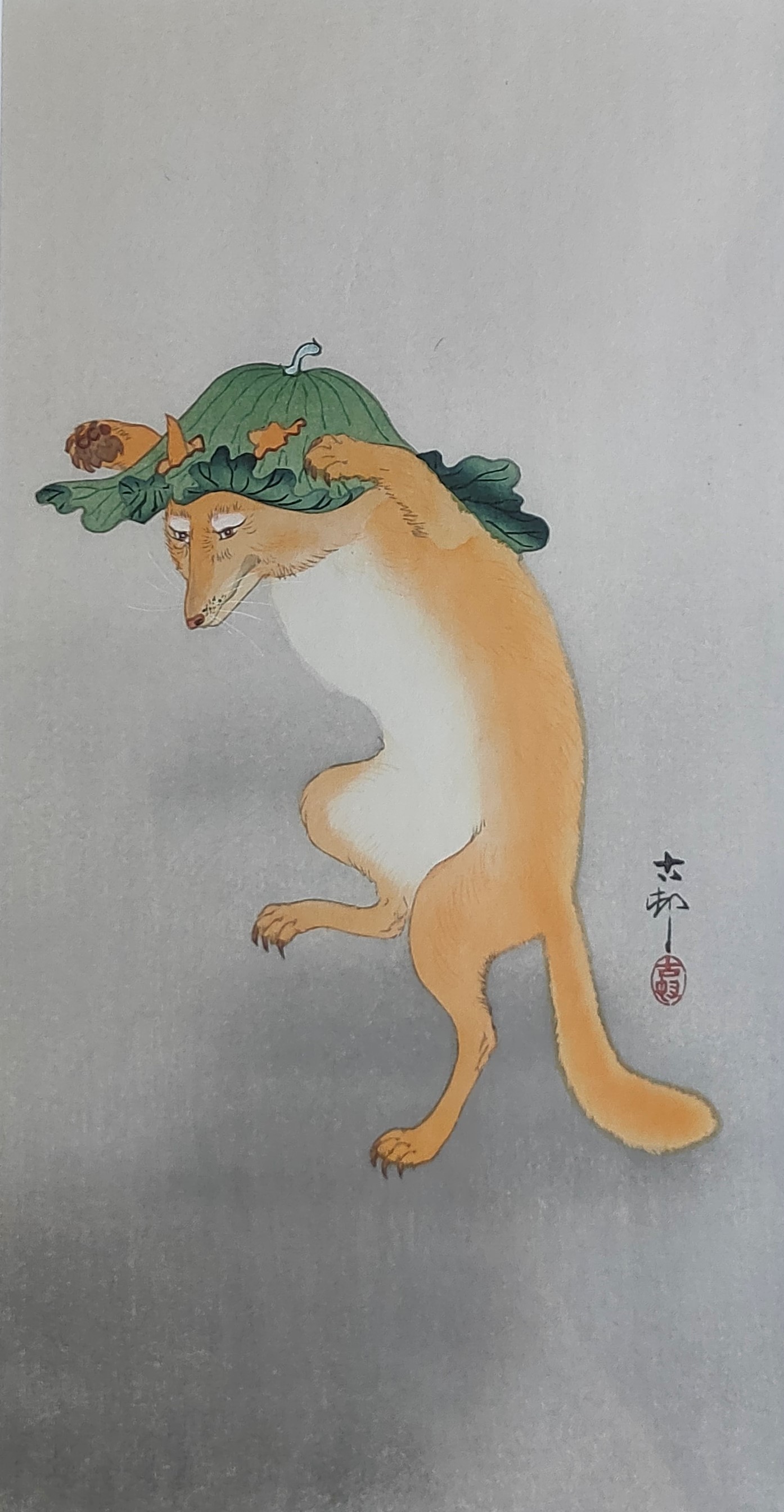
Koson Ohara (1877-1945) Renard dansant sous un nénuphar. Epreuve contemporaine. Tirage posthume. Dimensions : 34,8 cm x 18,4 cm Publication : Unsodo. Un exemplaire datant de 1910, au Musée Fine Art de Boston
Koson Ohara ( 1877-1945) Dancing Fox with Lotus-leaf Hat. He wears a hat made of a large lotus leaf. Dimensions : 34,8 cm x 18,4 cm. Publisher : Unsodo. A similar exemple in the Museum of Fine Art in Boston.
Estampe par Tsuchiya Koitsu (1870-1949) Etang Shinobazu dans le Sankei-en – jardin de Yokohama
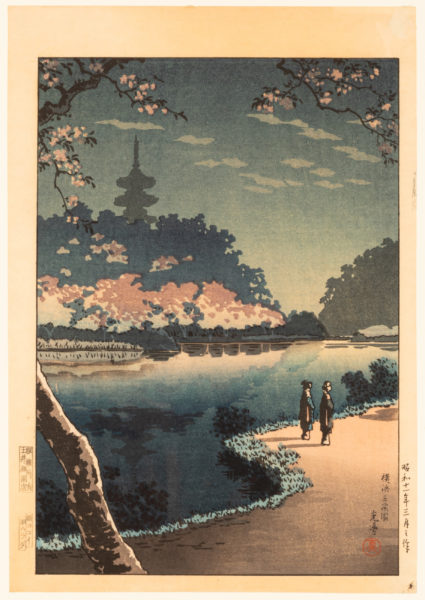
Estampe par Tsuchiya Koitsu (1870-1949). Ravissante composition offrant une vue du célèbre étang Shinobazu dans le Sankei-en – jardin de Yokohama. Deux femmes contemplant le paysage au bord de l’eau, apercevant le haut d’un temple s’élevant au-dessus des arbres, de cerisiers en fleurs teintés dans des tons de lilas à la tombée de la nuit. éditeur Doi Hangaten. Dimension Ogata-chuban, XXe siècle, vers 1940
Yokohama Sankei Garden (Shinobazu Pond) A lovely evening view of Shinobazu pond in the Yokohama Sankei Garden, with two beautiful women strolling along the shore. A temple spires rises above the tree tops across the water, the blossoming cherry trees below tinted in shades of lilac as the evening falls. Originally published in 1936, this print likely dates immediately following the War (as opposed to a later Doi-restrike). Born in 1879 in rural Japan with the given name Koichi. He became a student of the ukiyo-e master Kiyochika Kobayashi (1847-1915) after starting an apprenticeship for a woodblock carver who worked for Kobayashi. From 1931 on, Tsuchiya Koitsu became one of the artists working for the publisher Watanabe in the shin hanga style. His style is reminiscent of the works of his master Kobayashi and of the famous shin hanga artists Kawase Hasui and Hiroshi Yoshida. Publisher : Doi Hangaten Ogata-chuban Around 1940
Estampe : Shiro Kasamatsu (1898-1991) – Brume du soir sur l’étang Shinobazu
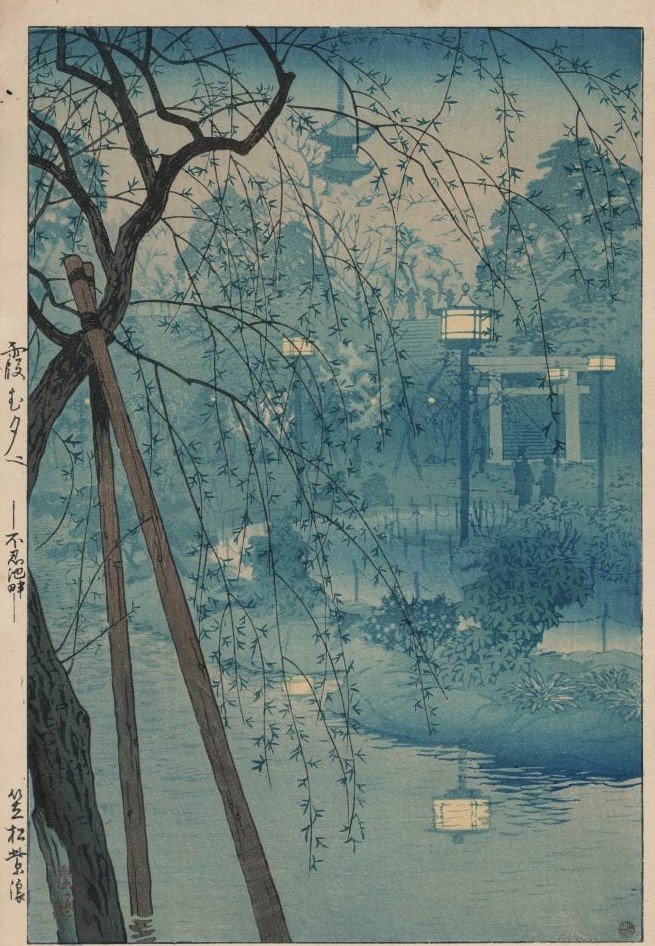
Shiro Kasamatsu (1898-1991) – Brume du soir sur l’étang Shinobazu L’étang Shinobazu est une pièce d’eau dans le parc d’Ueno de Tokyo. Le parc se trouve à l’emplacement du temple Kan’ei-ji, temple associé aux shoguns Tokugawa et détruit à la révolution de Meiji en 1868. L’étang Shinobazu est un endroit très célèbre de Tokyo et figure dans de nombreuses œuvres d’art dont de multiples estampes. 20e siècle, impression originale en 1932 – Impression de l’oeuvre : 1940s-1950s Format Oban.
Shiro Kasamatsu (1898-1991), Hazy Evening at the Edge of Shinobazu Pond A breathtakingly delicate woodblock print “Kasumu Yube, Shinobazu Chihan” (Misty Evening at Shinobazu Pond) by Shiro Kasamatsu. Very soft and subtle spring image. Superbly elegant composition. Title “霞む夕べ”(Kasumu Yube), subtitle “不忍池畔” (Shinobazu Chihan), and artist name “笠松紫浪”(Kasamatsu Shiro) on the left margin. This is a later printing (1946-1957) as denoted by the Watanabe 6mm seal (1946-1957) on the lower-left corner of the image. Shiro was born in Tokyo in 1898, and was apprenticed at the age of 13 to Kaburagi Kiyokata (1878–1973), a traditional master of bijin-ga. Kasamatsu however took an interest in landscape and was given the pseudonym “Shiro” by his teacher.
Netsuke – Momotaro dans sa pêche
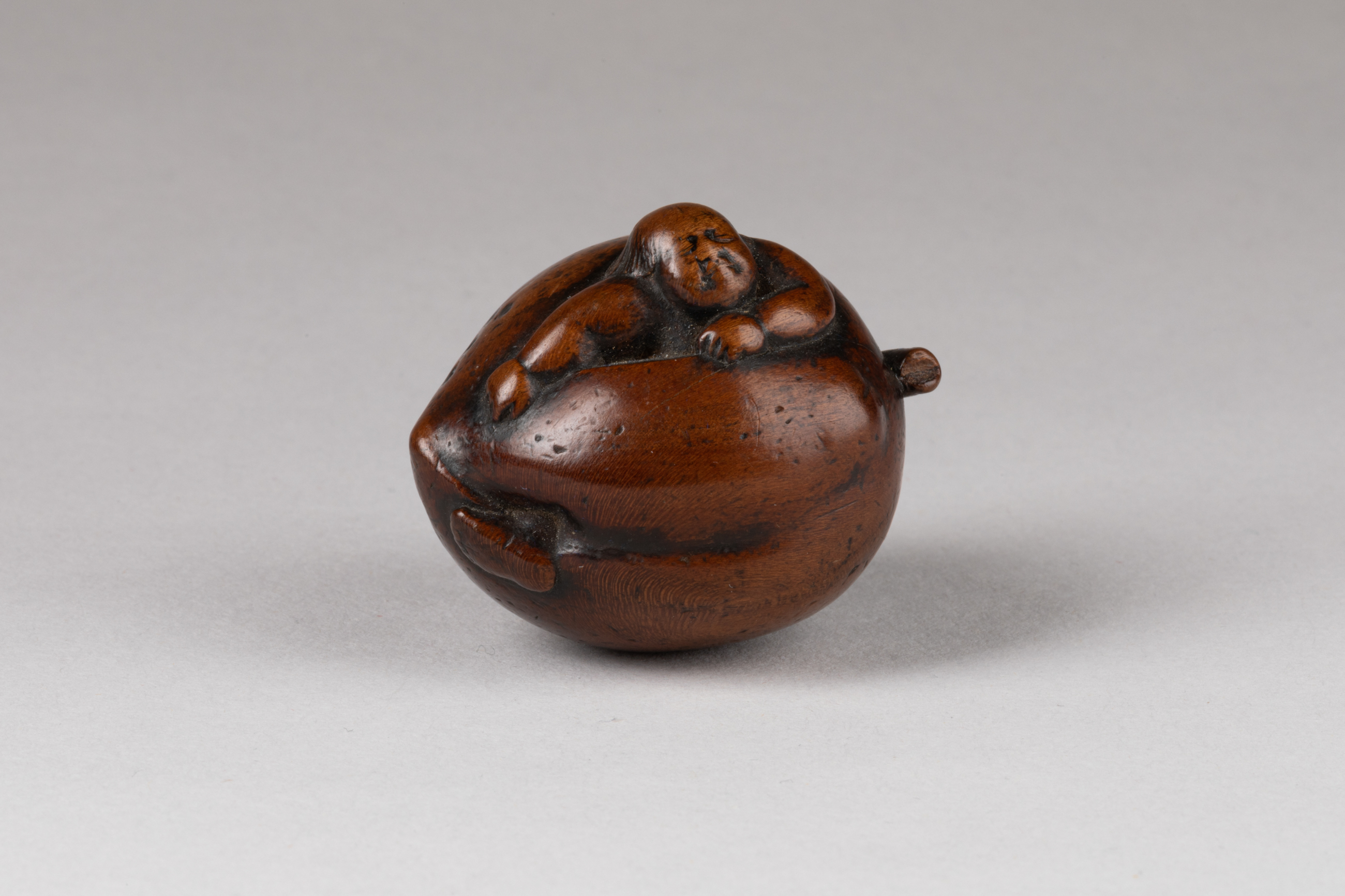
Netsuke – Joli netsuke en buis sculpté représentant Momotaro, petit personnage sorti du folklore japonais. Momo signifie pêche (le fruit) en japonais alors que Taro est un prénom masculin populaire dans l’archipel, en l’occurrence le nom de premier fils de la famille. Japon Edo (1603-1868) début du XIXe siècle. Longueur : 4 cm. Sa légende, très connue, est la suivante : Momotaro est né dans une pêche. Il fut découvert par une dame âgée qui lavait son linge dans une rivière. Elle le ramena chez elle et adopta le jeune Momotaro. Celui-ci leur annonça alors que les dieux des cieux l’avaient envoyé pour devenir leur fils. Un jour qu’il était parti chercher du petit bois, voici que Momotaro s’en revint avec l’arbre tout entier ! Le seigneur impressionné lui demanda de quitter famille et maison afin de combattre pour lui des démons ayant élus domicile sur l’île d’Onigashima. Le jeune Momotaro se mit en route. Chemin faisant, il rencontre trois créatures avec lesquelles il deviendra ami : un chien, un singe et un faisan. Ensemble ils parviendront à gagner cette bataille. Après cette victoire, Momotaro et ses compères retournèrent chez les parents adoptifs du garçon, les poches pleines des richesses subtilisées aux démons vaincus.
Netsuke – A godd wood model of Momotaro, (桃太郎, « Peach Boy ») is a popular hero of japanese folklore. His name translates as Peach Taro, a common Japanese name, and is often translated as Peach Boy. Momotarō was born from a giant peach, which was found floating down a river by an old, childless woman who was washing clothes there. The child explained that he had been bestowed by the Gods to be their son. The couple named him Momotarō, from momo (peach) and tarō (eldest son in the family). Length : 4 cm. Japan Edo (1603-1868) 19th century













